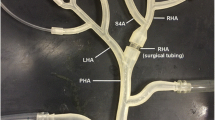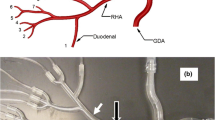Abstract
Purpose
Size of the embolic microspheres is of critical importance in the transcatheter arterial chemoembolization (TACE) of hepatocellular carcinoma (HCC) to achieve the optimal embolization therapy. In this regard, to optimize the size distribution of the embolic microspheres and enhance the embolization efficacy, the aggregate gradation theory is used to formulate the microspheres.
Methods
Finite element analysis (FEA) and in vitro experiments confirmed a better embolic efficacy for the poly(vinyl alcohol) (PVA) microspheres formulated according to the aggregate gradation theory.
Results
The average volume flow of the graded group was 1.31 × 10−4 mL/s in vitro experiment, which was lowest among all the groups suggesting the graded group had the optimal embolic effect. The graded group has the largest pressure gradient of 314.22 Pa/μm in FEA among all the groups, which can be attributed to the highest packing density of the graded group compared with other groups.
Conclusions
The graded embolic microspheres have a larger drag coefficient compared with the narrow size distribution groups both in vitro experiment and FEA. These findings can be used to formulate the embolic agents with optimal size distributions and are significant for the improvement of clinical embolization therapy.








Similar content being viewed by others
References
Akinwande, O. K., P. Philips, P. Duras, S. Pluntke, C. Scoggins, and R. C. Martin. Small versus large-sized drug-eluting beads (DEBIRI) for the treatment of hepatic colorectal metastases: a propensity score matching analysis. Cardiovasc. Intervent. Radiol. 38:361–371, 2015.
Bannerman, D., and W. Wan. Multifunctional microbeads for drug delivery in TACE. Expert Opin. Drug Deliv. 13:1289–1300, 2016.
Barentsz, M. W., M. A. Vente, M. G. Lam, M. L. Smits, J. F. Nijsen, B. A. Seinstra, C. E. Rosenbaum, H. M. Verkooijen, B. A. Zonnenberg, and M. A. Van den Bosch. Technical solutions to ensure safe yttrium-90 radioembolization in patients with initial extrahepatic deposition of (99m) technetium-albumin macroaggregates. Cardiovasc. Intervent. Radiol. 34:1074–1079, 2011.
Basciano, C. A., C. Kleinstreuer, and A. S. Kennedy. Computational fluid dynamics modeling of 90Y microspheres in human hepatic tumors. J. Nucl. Med. 02:1000112, 2011.
Basciano, C. A., C. Kleinstreuer, A. S. Kennedy, W. A. Dezarn, and E. Childress. Computer modeling of controlled microsphere release and targeting in a representative hepatic artery system. Ann. Biomed. Eng. 38:1862–1879, 2010.
Bastiana, P., R. Bartkowski, H. Köhlerb, and T. Kissela. Chemo-embolization of experimental liver metastases. Part I: distribution of biodegradable microspheres of different sizes in an animal model for the locoregional therapy. Eur J Pharm Biopharm 46:243–254, 1998.
Bathe, K. J., H. Zhang, and M. H. Wang. Finite element analysis of incompressible and compressible fluid flows with free surfaces and structural interactions. Comput. Struct. 56:193–213, 1995.
Bonne, L., C. Verslype, A. Laenen, S. Cornelissen, C. M. Deroose, H. Prenen, V. Vandecaveye, E. Van Cutsem, and G. Maleux. Safety and efficacy of doxorubicin-eluting superabsorbent polymer microspheres for the treatment of liver metastases from neuroendocrine tumours: preliminary results. Radiol. Oncol. 51:74–80, 2017.
Caine, M., D. Carugo, X. Zhang, M. Hill, M. R. Dreher, and A. L. Lewis. Review of the development of methods for characterization of microspheres for use in embolotherapy: translating bench to cathlab. Adv. Healthc. Mater. 6:1601291, 2017.
Caine, M., D. Carugo, X. Zhang, M. Hill, M. R. Dreher, and A. L. Lewis. Review of the development of methods for characterization of microspheres for use in embolotherapy: translating bench to cathlab. Adv. Healthc. Mater. 6:1061291, 2017.
Carugo, D., L. Capretto, B. Roy, M. Carboni, M. Caine, A. L. Lewis, M. Hill, S. Chakraborty, and X. Zhang. Spatiotemporal dynamics of doxorubicin elution from embolic beads within a microfluidic network. J. Control. Release 214:62–75, 2015.
Fabbri, D., Q. Long, S. Das, and M. Pinelli. Computational modelling of emboli travel trajectories in cerebral arteries: influence of microembolic particle size and density. Biomech. Model. Mechanobiol. 13:289–302, 2014.
Fang, M., D. Park, J. L. Singuranayo, H. Chen, and Y. Li. Aggregate gradation theory, design and its impact on asphalt pavement performance: a review. Int J Pavement Eng 2018. https://doi.org/10.1080/10298436.2018.1430365.
Forster, R. E., F. Thurmer, C. Wallrapp, A. W. Lloyd, W. Macfarlane, G. J. Phillips, J. P. Boutrand, and A. L. Lewis. Characterisation of physico-mechanical properties and degradation potential of calcium alginate beads for use in embolization. J. Mater. Sci. Mater. Med. 21:2243–2251, 2010.
Fuchs, K., R. Duran, A. Denys, P. E. Bize, G. Borchard, and O. Jordan. Drug-eluting embolic microspheres for local drug delivery-State of the art. J. Control. Release 262:127–138, 2017.
Fuller, W. B. The laws of proportioning concrete. J. Trans. Div. Am. Soc. Civ. Eng. 59:67–143, 1907.
Giunchedi, P., M. Maestri, E. Gavini, P. Dionigi, and G. Rassu. Transarterial chemoembolization of hepatocellular carcinoma. Expert Opin. Drug Deliv. 10:679–690, 2013.
Guadagni, S., A. Pizzutilli, E. Mancini, A. Varrone, G. Palumbo, G. Amicucci, S. Perri, M. Deraco, and G. Fiorentini. Significance of duplex/colour Doppler sonography in hepatic arterial chemotherapy for patients with liver metastases from colorectal carcinoma. Eur. J. Surg. Oncol. 26:381–386, 2000.
Han, G. H., S. Berhane, H. Toyoda, D. Bettinger, O. Elshaarawy, A. W. H. Chan, M. Kirstein, et al. Prediction of survival among patients receiving transarterial chemoembolization for hepatocellular carcinoma: a response-based approach. Hepatology 72:198–212, 2020.
Heaysman, C. L., G. J. Philips, A. W. Lloyd, and A. L. Lewis. Unusual behaviour induced by phase separation in hydrogel microspheres. Acta Biomater. 53:190–198, 2017.
Hidaka, K., L. Moine, G. Collin, D. Labarre, J. L. Grossiord, N. Huang, K. Osuga, S. Wada, and A. Laurent. Elasticity and viscoelasticity of embolization microspheres. J. Mech. Behav. Biomed. Mater. 4:2161–2167, 2011.
Hutter, J. L., and J. Bechhoefer. Calibration of atomic force microscope tips. Rev. Sci. Instrum. 64:1868–1873, 1993.
Ladyzhenskaya, A. O. Mathematical analysis of Navier-Stokes equations for incompressible liquids. Annu. Rev. Fluid Mech. 7:249–272, 1975.
Laurent, A., E. Velzenberger, M. Wassef, J. P. Pelage, and A. L. Lewis. Do microspheres with narrow or standard size distributions localize differently in vasculature? An experimental study in sheep kidney and uterus. J. Vasc. Interv. Radiol. 19:1733–1739, 2008.
Laurent, A., M. Wassef, J. P. Saint Maurice, J. Namur, J. P. Pelage, A. Se-ron, R. Chapot, and J. J. Merland. Arterial distribution of calibrated tris-acryl gelatin and polyvinyl alcohol microspheres in a sheep kidney model. Investig. Radiol. 41:8–14, 2006.
Leen, E., J. A. Goldberg, J. Robertson, G. R. Sutherland, D. M. Hemingway, T. G. Cooke, and C. S. McArdle. Detection of hepatic metastases using duplex/color doppler sonography. Ann. Surg. 214:599–604, 1991.
Lira, B., D. Jelagin, and B. Birgisson. Gradation-based framework for asphalt mixture. Mater. Struct. 46:1401–1414, 2012.
Martin, R., J. Irurzun, J. Munchart, I. Trofimov, A. Scupchenko, C. Tatum, and G. Narayanan. Optimal technique and response of doxorubicin beads in hepatocellular cancer: bead size and dose. Korean J. Hepatol. 17:51–60, 2011.
Oktar, S. O., C. Yucel, T. Demirogullari, A. Uner, M. Benekli, G. Erbas, and H. Ozdemir. Doppler sonographic evaluation of hemodynamic changes in colorectal liver metastases relative to liver size. J. Ultrasound Med. 25:575–582, 2006.
Padia, S. A., G. Shivaram, S. Bastawrous, P. Bhargava, N. J. Vo, S. Vaidya, K. Valji, W. P. Harris, D. S. Hippe, and M. J. Kogut. Safety and efficacy of drug-eluting bead chemoembolization for hepatocellular carcinoma: comparison of small-versus medium-size particles. J. Vasc. Interv. Radiol. 24:301–306, 2013.
Poursaid, A., M. M. Jensen, E. Huo, and H. Ghandehari. Polymeric materials for embolic and chemoembolic applications. J. Control. Release 240:414–433, 2016.
Richards, A. L., C. Kleinstreuer, A. S. Kennedy, E. Childress, and G. D. Buckner. Experimental microsphere targeting in a representative hepatic artery system. IEEE Trans. Biomed. Eng. 59:198–204, 2011.
Roberson, P. L., R. K. T. Haken, D. L. McShan, P. E. McKeever, and W. D. Ensminger. Three-dimensional tumor dosimetry for hepatic yttrium-90-microsphere therapy. J. Nucl. Med. 33:735–738, 1992.
Salem, R., R. J. Lewandowski, M. F. Mulcahy, A. Riaz, R. K. Ryu, S. Ibrahim, B. Atassi, T. Baker, V. Gates, F. H. Miller, K. T. Sato, E. Wang, R. Gupta, A. B. Benson, S. B. Newman, R. A. Omary, M. Abecassis, and L. Kulik. Radioembolization for hepatocellular carcinoma using yttrium-90 microspheres: a comprehensive report of long-term outcomes. Gastroenterology 138:52–64, 2010.
van den Hoven, A. F., M. G. Lam, S. Jernigan, M. A. van den Bosch, and G. D. Buckner. Innovation in catheter design for intra-arterial liver cancer treatments results in favorable particle-fluid dynamics. J. Exp. Clin. Cancer Res. 34:74, 2015.
Wig, R., G. Williams, and E. Gates. Strength and Other Properties of Concrete as Affected by Materials and Methods of PreparationTech Bu Stand No. 58, Washington, DC: US Government Printing Office, 1916.
Xiao, Y. D., C. Ma, Z. S. Zhang, and J. Liu. Safety and efficacy assessment of transarterial chemoembolization using drug-eluting beads in patients with hepatocellular carcinoma and arterioportal shunt: a single-center experience. Cancer Manag. Res. 11:1551–1557, 2019.
Xu, Z., S. Jernigan, C. Kleinstreuer, and G. D. Buckner. Solid tumor embolotherapy in hepatic arteries with an anti-reflux catheter system. Ann. Biomed. Eng. 44:1036–1046, 2016.
Zhang, X., H. L. H. Ng, A. Lu, C. Lin, L. Zhou, G. Lin, Y. Zhang, Z. Yang, and H. Zhang. Drug delivery system targeting advanced hepatocellular carcinoma: current and future. Nanomedicine 12:853–869, 2016.
Acknowledgments
The authors want to thank Mr. Li Gong at the Instrumental Analysis and Research Centre (Sun Yat-sen University) for his assistance in AFM. This work was supported by the National Natural Science Foundation of China (Grant No.: 81971760), and the Science and Technology Planning Project of Guangdong Province (Grant No.: 2015B010125004).
Conflict of interest
The content of this manuscript is original which has not been published previously in any other journal at the time of submission. All authors declare no conflict of interest.
Author information
Authors and Affiliations
Corresponding authors
Additional information
Associate Editor Zhongjun Wu oversaw the review of this article.
Publisher's Note
Springer Nature remains neutral with regard to jurisdictional claims in published maps and institutional affiliations.
Supplementary Information
Below is the link to the electronic supplementary material.
Rights and permissions
About this article
Cite this article
Huang, D., Chen, Z., Yang, Y. et al. Enhanced Embolization Efficacy with the Embolic Microspheres Guided by the Aggregate Gradation Theory Through In Vitro and Simulation Evaluation. Cardiovasc Eng Tech 12, 398–406 (2021). https://doi.org/10.1007/s13239-021-00534-x
Received:
Accepted:
Published:
Issue Date:
DOI: https://doi.org/10.1007/s13239-021-00534-x




